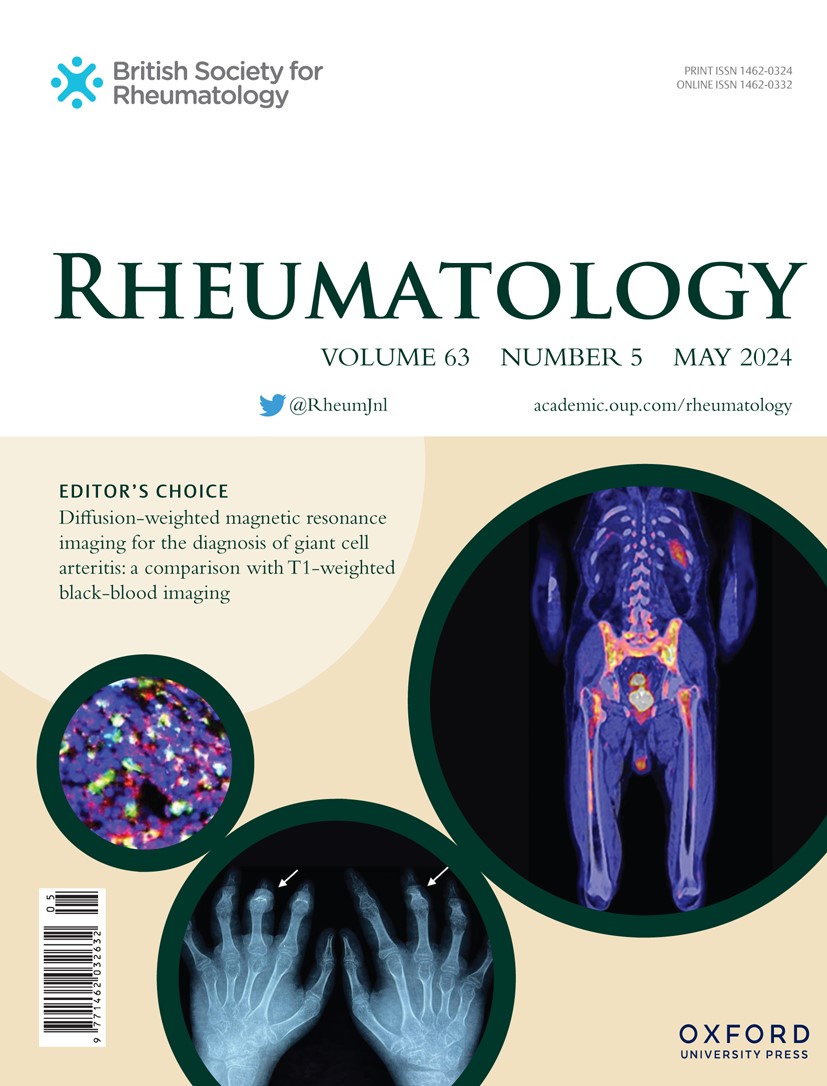Automated detection of spinal bone marrow oedema in axial spondyloarthritis: training and validation using two large phase 3 trial datasets
IF 4.7
2区 医学
Q1 RHEUMATOLOGY
引用次数: 0
Abstract
Objective To evaluate the performance of machine learning (ML) models for the automated scoring of spinal MRI bone marrow oedema (BMO) in patients with axial spondyloarthritis (axSpA) and compare them with expert scoring. Methods ML algorithms using SpineNet software were trained and validated on 3483 spinal MRIs from 686 axSpA patients across two clinical trial datasets. The scoring pipeline involved (i) detection and labelling of vertebral bodies and (ii) classification of vertebral units for the presence or absence of BMO. Two models were tested: Model 1, without manual segmentation, and Model 2, incorporating an intermediate manual segmentation step. Model outputs were compared with those of human experts using kappa statistics, balanced accuracy, sensitivity, specificity, and AUC. Results Both models performed comparably to expert readers, regarding presence vs absence of BMO. Model 1 outperformed Model 2, with an AUC of 0.94 (vs 0.88), accuracy of 75.8% (vs 70.5%), and kappa of 0.50 (vs 0.31), using absolute reader consensus scoring as the external reference; this performance was similar to the expert inter-reader accuracy of 76.8% and kappa of 0.47, in a radiographic axSpA dataset. In a non-radiographic axSpA dataset, Model 1 achieved an AUC of 0.97 (vs 0.91 for Model 2), accuracy of 74.6% (vs 70%), and kappa of 0.52 (vs 0.27), comparable to the expert inter-reader accuracy of 74.2% and kappa of 0.46. Conclusion ML software shows potential for automated MRI BMO assessment in axSpA, offering benefits such as improved consistency, reduced labour costs, and minimised inter- and intra-reader variability. Trial registration Clinicaltrials.gov, MEASURE 1 study (NCT01358175); PREVENT study (NCT02696031)轴性脊柱性关节炎脊髓骨髓水肿的自动检测:使用两个大型3期试验数据集进行训练和验证
目的评价机器学习(ML)模型在中轴性脊柱炎(axSpA)患者脊柱MRI骨髓水肿(BMO)自动评分中的性能,并与专家评分进行比较。方法使用SpineNet软件对686例axSpA患者的3483张脊柱mri进行训练并验证ML算法。评分流程包括(i)对椎体的检测和标记以及(ii)对存在或不存在BMO的椎单位进行分类。我们测试了两个模型:模型1没有人工分割,模型2加入了中间的人工分割步骤。使用kappa统计,平衡准确性、灵敏度、特异性和AUC,将模型输出与人类专家的输出进行比较。结果两种模型在存在与不存在BMO方面的表现与专家读者相当。模型1优于模型2,AUC为0.94 (vs 0.88),准确率为75.8% (vs 70.5%), kappa为0.50 (vs 0.31),使用绝对读者共识评分作为外部参考;这一性能与放射学axSpA数据集中的专家读者间准确率76.8%和kappa 0.47相似。在非射线成像的axSpA数据集中,模型1的AUC为0.97(模型2为0.91),准确度为74.6%(模型2为70%),kappa为0.52(模型2为0.27),与专家读者间准确度74.2%和kappa为0.46相当。结论:ML软件在axSpA中显示了自动化MRI BMO评估的潜力,提供了诸如提高一致性,降低劳动力成本和最大限度地减少阅读器之间和内部差异等好处。Clinicaltrials.gov, MEASURE 1研究(NCT01358175);PREVENT研究(NCT02696031)
本文章由计算机程序翻译,如有差异,请以英文原文为准。
求助全文
约1分钟内获得全文
求助全文
来源期刊

Rheumatology
医学-风湿病学
CiteScore
9.40
自引率
7.30%
发文量
1091
审稿时长
2 months
期刊介绍:
Rheumatology strives to support research and discovery by publishing the highest quality original scientific papers with a focus on basic, clinical and translational research. The journal’s subject areas cover a wide range of paediatric and adult rheumatological conditions from an international perspective. It is an official journal of the British Society for Rheumatology, published by Oxford University Press.
Rheumatology publishes original articles, reviews, editorials, guidelines, concise reports, meta-analyses, original case reports, clinical vignettes, letters and matters arising from published material. The journal takes pride in serving the global rheumatology community, with a focus on high societal impact in the form of podcasts, videos and extended social media presence, and utilizing metrics such as Altmetric. Keep up to date by following the journal on Twitter @RheumJnl.
 求助内容:
求助内容: 应助结果提醒方式:
应助结果提醒方式:


